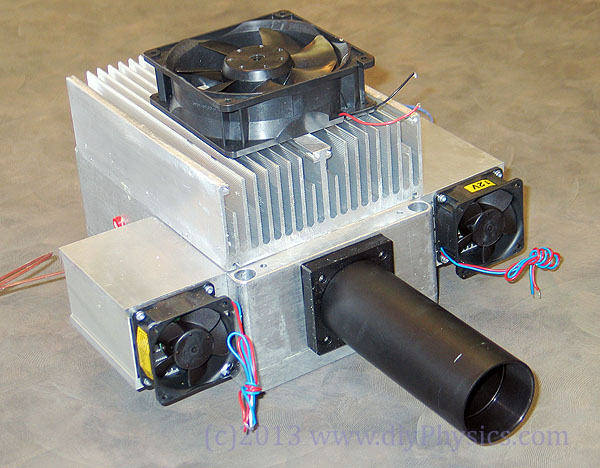
The photomultiplier tubes (PMT) is the workhorse detector in particle physics and many other fields that require detection of light at extremely low levels. However, the long-wavelength response of PMTs is not only low because of low quantum efficiency, but also because thermionic emission at room temperature causes swamps low-level signals with noise.
Reducing dark counts is especially important in photon-counting applications, especially when attempting to detect photons in the near-infrared. For example, the dark count of many PMTs rated for a wavelength range from 400 to 1200 nm, is in the hundred of thousands of counts when not cooled—making it virtually useless for detecting almost anything but the strongest signal. When cooled to -20 °C, the dark count is reduced to just a few tens counts. As such, in general, the use of PMTs that detect above 600 nm almost mandate a cooled housing.
We constructed a thermoelectrically-cooled housing to experiment with cooling a standard 2” face-on PMT. Although appropriate PMT noise reduction was achieved (one order of magnitude), the thermal efficiency of the do-it-yourself housing design was low, so lessons learned from this build will be used in a second-generation cooled housing.

In the dark and at room temperature, the dominant mode of photocathode emission is thermionic. The figure above shows the effect of temperature on dark counts for typical photocathode types, demonstrating that PMT photocathode cooling is highly advantageous in low level detection. This figure also shows that for standard photocathode materials there is little advantage in cooling below -25 °C.

For this project we retrofitted the PMT probe that we described in Chapter 2 of our book “Exploring Quantum Physics Through Hands-On Projects” with thermoelectric cooling (TEC) modules. We started the conversion by tightly wrapping the PMT with CONETIC magnetic shielding sheet. The shield was held together with aluminum adhesive tape. The outer diameter of the shield was made to fit snuggly inside a Thorlabs XT66-100.

Then, four 2-stage thermoelectric cooling modules were glued with Artic Silver epoxy adhesive to the Thorlabs XT66-100 construction rail enclosing the PMT. The hot sides of the TEC modules were glued with the same adhesive to two machined aluminum blocks that serve as thermal interfaces to the die-cast enclosure.

The PMT/thermoelectric cooling module assembly fits tightly inside the die-cast aluminum enclosure. Silver-loaded heat-conductive paste is used to ensure appropriate heat transfer between the aluminum blocks and the enclosure. we placed one K-type and one T-Type thermocouple in good thermal contact with the construction rail at the location of the PMT’s cathode. The thermocouples were held in contact with the rail using Kapton tape, and a dab of Artic Silver epoxy was used to ensure proper thermal contact.

We used sheets of 0.079″-thick aerogel thermally insulate the PMT assembly from the aluminum blocks and die-cast enclosure. Lastly, we sprayed expanding foam insulation into all cavities prior to closing the enclosure.

The figure above shows the effect of cooling on a RCA6655A PMT. The dark counts due to thermoelectrons were reduced by an order of magnitude when temperature was reduced from ambient 23⁰C to -13.5⁰C.
Although we believed that the design would provide effective cooling of the PMT, and were originally hoping that the large top heatsink and fan plus only two of the four TEC modules would be needed to cool the PMT to the target -20°C. That was obviously not the case, requiring the use of all four TEC modules, and the addition of two forced-air tunnel heatsinks to the sides of the enclosure to barely reach -13°C at a 23°C room temperature.
Under ideal conditions with no heat load and in vacuum, the 2-stage TEC modules that we chose are capable of producing temperature differentials as great as ΔTmax= 83°C. The enclosure we built however is far from ideal, reaching a ΔTmax≈ 40°C. The difference between the ideal and actual performance is mostly the result of gradients that exist at the various interfaces between the photomultiplier and the heat exchange medium. In addition, there is also a heat load from dynode chain dissipation and an important amount of heat transferred from the housing case through the insulation.
In a future design, the following will be considered to improve the cooling efficiency of the housing:
- Tighter coupling between the TEC’s hot side and the heat sink.
- Use of a water-cooled heat-sink.
- Use of a metal-jacket PMT
A complete white paper describing our build is available here: Prutchi diy PMT Cooled Enclosure March 2013
The following are useful references:
Find more useful information through the Internet Archive
